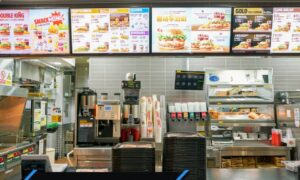Embark on a culinary journey into the future of dining, where innovation takes center stage, transforming the selection and enjoyment of meals: the emergence of augmented reality menus. Bid adieu to conventional printed menus and embrace an entirely novel culinary exploration. This article takes you deep into the realm of these state-of-the-art technologies that are reshaping the restaurant landscape, elevating our dining escapades to unprecedented heights. Prepare to indulge in tantalizing visuals, interactive culinary offerings, and an unforgettable gastronomic expedition as we open the gateway to an era where ordering food evolves into an immersive and enthralling encounter.
Introducing Augmented Reality Menus
Augmented reality (AR) has rapidly infiltrated mainstream usage through applications like Snapchat filters and Pokémon Go. However, its significance extends beyond mere entertainment, as it is now catalyzing a transformation in the restaurant sphere.
Augmented reality menus stand as a prime example of AR’s application in restaurants. These menus leverage AR technology to offer diners an interactive dining affair. For instance, patrons can employ their smartphones to access 3D models of potential dishes, allowing them to gain a more comprehensive understanding of their culinary choices and facilitating informed decision-making.
Moreover, AR menus can provide nutritional insights about menu offerings. They also prove advantageous for individuals seeking specific dietary options, such as gluten-free or vegetarian selections, by simplifying the process of finding suitable dishes.
Therefore, for those seeking more immersive and informative dining experiences, keep an eye out for eateries that embrace augmented reality menus.
Advantages of Augmented Reality Menus
Augmented reality menus carry a host of benefits for the restaurant industry. First and foremost, they contribute to a heightened, interactive dining environment for patrons. By enabling patrons to engage with digital content in conjunction with their physical surroundings, AR menus enhance the dining encounter, rendering it more captivating and memorable. Additionally, AR menus excel in furnishing diners with detailed information about available dishes. For instance, these menus can showcase imagery or videos of dish preparation, or offer nutritional particulars about each culinary creation. This facet proves particularly invaluable for restaurants featuring intricate or unfamiliar dishes, as it aids patrons in comprehending their selections and making well-informed dining decisions. The utilization of AR menus also bears the potential to economize printing costs, as it replaces conventional paper menus with electronic counterparts.
Elevating the Dining Experience Through AR Menus
Augmented reality (AR) has swiftly ingrained itself across diverse sectors, spanning from retail to manufacturing. Notably, the restaurant domain is no exception, with AR menus ushering in a novel and enriched dining adventure for customers.
AR menus extend manifold advantages to both restaurants and patrons. Restaurants can exploit AR menus for upselling and highlighting specific menu items. Additionally, these menus offer insights into ingredient details and nutritional facts, contributing to informed decision-making among diners. For customers, AR menus provide an augmented, interactive dining episode. These menus also play a pivotal role in aiding patrons as they ponder over their meal choices.
Various approaches exist for implementing AR menus. A popular approach involves QR codes, which can be positioned on tables or featured in printed menus. Scanning these codes via smartphones grants access to AR menus, enriching the browsing experience. Alternatively, dedicated AR apps can be employed, downloadable by diners to access AR menus for particular restaurants.
Irrespective of implementation, AR menus promise to amplify the dining experience, benefiting both restaurants and patrons alike.
Instances of Restaurants Embracing Augmented Reality Menus
Numerous restaurants have adopted augmented reality menus to heighten their customers’ dining encounters. A prime instance is the Hard Rock Cafe, which has introduced an app enabling customers to peruse nutritional information for each menu item. This proves especially advantageous for those inclined towards healthier choices when dining out.
Olive Garden, another exemplar, has devised an augmented reality menu offering patrons the ability to preview dishes through photos and videos prior to selection. This innovation provides a sneak peek into the upcoming culinary experience and assists patrons in determining their preferences.
Furthermore, Red Robin has introduced an app facilitating order placement and payment via smartphones. This streamlined approach simplifies the ordering process and eliminates the need to queue at the cashier’s counter.
Challenges and Considerations Associated with AR Menus
The application of AR menus poses the challenge of necessitating customer possession of smartphones or compatible devices hosting the requisite apps. Restaurants must also ensure compatibility with the diverse range of devices used by their patrons. A related concern involves the willingness of customers to use personal devices for menu viewing, or the potential lack of compatibility.
Balancing the introduction of AR menus without overshadowing the overall dining experience presents another challenge. The objective is enhancement, not distraction. Apprehensions persist regarding potential obsolescence of AR menus in the face of evolving technology and emerging trends. Lastly, the concern arises that customers might encounter difficulties in navigating AR menus. Hence, it is imperative for restaurants to design menus that are intuitive and user-friendly, preventing customer frustration and potential attrition.
The Future Landscape of AR Menus
The future of AR menus appears exceedingly promising. As technology advances, restaurants will possess the capability to deliver distinctive dining experiences to customers through AR innovation. With AR’s integration, restaurants can design virtual menus tailored to individual customers, enabling patrons to visualize their selected orders with precision. Furthermore, AR menus offer the avenue to furnish comprehensive insights into dishes, encompassing nutrition data and allergen specifics. This inclusivity ensures a gratifying dining experience for all, irrespective of dietary constraints.
The evolution of AR menus will usher in greater interactivity, affording customers the opportunity to explore menu items in three-dimensional space or partake in augmented reality cooking demonstrations. Consequently, AR menus empower customers with immersive glimpses into served dishes and ingredient compositions, fostering heightened contentment and loyalty by enabling them to participate in their meal’s creation.
All in all, the horizon for AR menus is promising. Their capacity to provide personalized, engaging experiences positions them as an upcoming trend likely to be embraced by numerous restaurants.
Conclusion
Augmented reality menus are swiftly emerging as revolutionary tools within the modern restaurant landscape. As technology evolves, these AR-driven dining experiences will only become more immersive and captivating, allowing customers to discover novel dishes with unparalleled ease. Coupled with the diverse advantages AR menus bestow upon restaurant owners such as cost reduction, waste minimization, and heightened customer satisfaction this cutting edge technology seems primed to reshape the future of dining experiences.



































